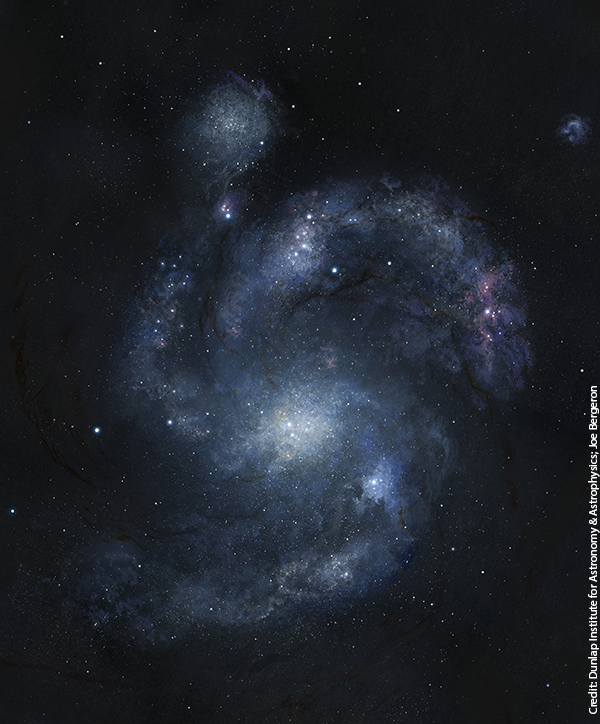
Spiral galaxies are common in the modern Universe: more than 75 percent of large galaxies are spirals. However, at cosmologically significant distances, they appear to be less common, indicating either that the conditions were wrong in the early Universe to create spiral structures, or current telescopes aren't good enough to distinguish the arms at those distances. A new observation has revealed a spiral galaxy about 10.7 billion light years away, the first unambiguous discovery of that type of galaxy from that cosmic era.
Using data from the Hubble Space Telescope and the Keck telescope in Hawaii, David R. Law and colleagues characterized the object labeled BX442 as a "grand design" spiral galaxy. In grand design spirals, the spiral arms are clearly defined and wind significantly around the galactic center.
The authors turned up BX442 in a survey of 306 galaxies at a similar distance from Earth, but it was the only one with obvious spiral morphology (the technical term for the general shape a galaxy takes). While a second galaxy, HDFX 28, appeared spiral in another sample and is approximately as far away, its spiral shape may be an illusion, based on the angle at which it appears to us. Even if HDFX 28 is truly spiral, the apparent number of spiral galaxies at that era in the Universe's history is still small.
Light from distant galaxies is redshifted—stretched by the expansion of spacetime to longer wavelengths. This means that visible light from distant galaxies will appear in the infrared part of the spectrum to observers on Earth
The researchers used infrared data from the Hubble Space Telescope's Wide-Field Camera 3 (WFC3) and from the Keck OSIRIS spectrograph to characterize BX442's structure. They identified two distinct arms and a probable third arm using emission from stars and ionized hydrogen gas. Spiral arms in modern galaxies trace the presence of star formation and the hottest, youngest stars, which also seems to be the case with BX442. In fact, based on analysis with the Keck ultraviolet Low Resolution Imaging Spectrometer (LRIS), BX442 is hotter than comparable modern galaxies. The temperature is measured by the velocity of gas inside the galaxy, relative to the rotation rate of the galactic disk.
Other galaxies at cosmologically significant distances have similar masses, sizes, and disk structure, but lack spiral arms. To explain the difference, the authors pointed out the presence of a close companion galaxy, seen in the image at the top of this article, which may have disturbed BX442. Such perturbations are considered to be the source of structure in modern grand design spiral galaxies.
Because of the transient nature of gravitational disturbances, the researchers pointed out that BX442's spiral arms may have been a temporary feature. If that was the case, it would also help explain why no other galaxies in the sample of 306 possessed spiral arms: they hadn't experienced a close passage within the time frame of the observation. However, it isn't possible to rule out selection effects entirely: BX442 is nearly face-on to Earth and very clear, but at the huge distances, not every galaxy is as beautifully defined.
Due to its extreme distance, BX442 is the earliest confirmed spiral galaxy in the Universe, and future study will reveal how unusual it is. Existing instruments on the Hubble and Keck telescopes were able to find and characterize a spiral galaxy unambiguously. Further surveys at this great distance should help settle whether BX442 is unique, or part of a larger population from the early days of galaxy formation in the Universe.
Nature, 2012. DOI: 10.1038/nature11256 (About DOIs).
reader comments
27